The ISEA2006/ZeroOne San Jose electronic arts festival site has launched. My piece of it is the C4F3, a cafe of augmented objects. It's described here and you can read about the 13 great pieces selected by our jury for inclusion in it. I'm going to continue working on this as I have been for the last 18 months, although now it's in a production phase, I'm happy to stand back and let the excellent team at ZeroOne do the heavy lifting. I invite all of you to come to San Jose in August and see it. It should be great. Tell your friends.
March 2006 Archives
Simultaneously with Radio Shack deciding to liquidate their line of Vex robotic poducts less than a year after they were introduced, the Mythbusters team review it positively.
Although much more of a Erector-set style construction kit than a rapid ubiquitous user experience sketching tool, it's clearly from the same universe of ideas, as Grant Imahara, one of the MB team puts it (in copy that's going to end up on a box soon, I'm sure):
With the VEX System, it’s not like you’re sacrificing a lot of time and energy just to try an idea. It’s quick and easy, and it promotes discovery through trial and error, which is what engineering is all about.
(tangentially, who names a potentially frustrating product "vex"--c'mon, marketing department!)
 +
+  =
= 
In the most recent edition of Innovation, the IDSA's magazine, an article(100K PDF) by James Conley got my interest. The subtitle is "Using Brand Identity to Reinforce Market Value," but the real point of the article is about how the basic elements of experience can be legally coralled and restricted as a form of competitive leverage. The importance of this is summarized in this key point:
If used properly, marks, unlike patents or copyrights, never expire. Registered design elements that serve as a brand foundation are therefore indefinite forms of competitive advantage.
Towards the end of the article he says:
Without the proactive management of intellectual property, the innovator’s ability to build and/or sustain market value is compromised. Designers who know how to legally encode a unique product differentiation and/or cognitive touch-point will have a strong competitive advantage.
This is all saying that our legal current system is so set up that ever-more specific sensory phenomena can become the property of organizations forever. And when "forever" and "property" are used in the same sentence, you know there's going to be trouble. My first thought about this related to an observation from a couple of years ago: digital technology has made color reproduction much more accurate, allowing designers much finer control over the exact color used in a product...and a much more consistent way of establishing ownership of a color. Old logos had to be in a relatively limited set of colors both because mass color reproduction technology was limited and because variability in printing technology made it much harder to insure consistency in a color. Coke own "red" (not a specific shade of red) partially because red is easy to reproduce. Pepsi owns "blue" for the same reason. It's not surprising that Tab Cola, which uses magenta as its signature color, was founded the year after Pantone: by the early 60s, color reproduction had probably gotten to the point that companies could use more subtle shades, and Pantone saw the need to standardize that capability. Since Pantone and, especially, since digital reproduction arrived in the 80s and 90s, accurate color reproduction has come to dominate the design world.
And now intellectual property theorists such as Conley, and lawyers, especially ones at technology and design-savvy companies with lots of money (read: phone companies) have realized that this is fresh, under-regulated ground for claiming territory (i.e. competitive advantage). Conley references T-Mobile's cease-and-desist complaint that made Intel change their Centrino logo to be less "magenta" (because both are in the "mobile" space, even though that makes no sense if you think about the context of use) and Orange's lawyers, who tried easyMobile to stop using orange in their advertising, despite easyMobile's reationship to easyJet, who are clearly very orange.
You can see this shift in large design-savvy companies already: DHL changed their logo colors to include the yellow of Deutsche Post, but also to differentiate itself from FedEx, who are quietly claiming more and more color territory. You can also see this with moving trucks: Ryder, Penske and Hertz used to all have yellow trucks; Budget had white. Ryder went to white. Budget went to blue in response. Hertz is moving to orange (I think). Penske gets to keep yellow, maybe.
I predict that soon, because there is no regulation in this market and ownership apparently forever, there will be major color wars to register colors for specific industries and uses and masses of litigation about color infringement, all created by the fidelity of color reproduction.
Now here comes the chilling part. Conley describes extending these ideas to other senses:
Beyond the world of static shape and form, Yamaha has succeeded in registering a stream of water as the unique source identifier for the Wave Runner line of personal watercraft. That’s right, that silly, rooster-tail shaped jet that fires up off the back of the unit when you crank the throttle is a registered trademark. This water stream is the monopoly source identifier of Yamaha’s Wave Runner and cannot be found on competing products from Polaris or Seadoo.[...]
Midwest Biologicals Inc. has registered the scent of bubblegum as a source identifier on its machining oil and metal-cutting fluids.
[...]
Akzo-Novel’s subsidiary Organon is now attempting to register an orange flavor as a trademark in the market for pharmaceutical antidepressants.
I'll leave the consequences of a logical conclusion to this line of thought to the reader.
Following up on my earlier post and attempting to include the terms that Adam and Bruce introduced, I wrote a sentence using all of the appropriate ubicomp buzzwords, as an attempt to create a narrative that ties together the fields, at least semantically. Here it is, in all its gory detail:
To create a world of ambient, ubiquitous intelligence, we will use physical, pervasive, often portable, information processing objects, which we will refer to individually as spimes and appliances, and collectively as everyware.
Liz is right of course when she tells me that it's a questionable exercise, when there is no master narrative and all of these terms emerge as products of different cultures, and Anne is right that creating rigid boundaries around terminology can be exclusionary of ideas and people, but I think it's valuable when trying to wrap my brain around the stuff. Or at least it'll make for magnetic poetry fodder.
Although I went to Etech this year to talk about sketching in hardware in theory, theory rapidly and surprisingly turned into practice the evening of the Maker Fair. Phil Torrone of Make challenged Tod Kurt, who is responsible for the Roomba serial and bluetooth hacks in Make, to an impromptu three-way Roomba "cockfight" (interpret that as you will, but it was Phil's term ;-). With Phil driving one Roomba, Tod driving the other, and Jeff Han driving a third one (using a Tod bluetooth puck) an impromptu game of Roomba sumo wrestling (with the "ring" defined as the edges of a table) commenced. As this was a Make Magazine event, people immediately started decorating the Roombas and inventing rules for the game. It was excellently geeky: Tod wrote control code in the 30-second pauses between bouts and Jeff strapped a camera to the top of one of the Roombas, capturing some terrific crash footage.
Here are photos:
It looks like the idea has now spread to SXSW (I suspect Phil):
Again, watch this space for more info. More Roomba games to come! Go Tod!
[Update: Phil has posted a link to some videos of the event]
[Update 2: One Phil's Roombas has sacrificed itself--or, really, it was sacrificed--to the cause of drunken vaccum/robot-based videogame parody. Go Phil and Limor!]
Last week I had the pleasure and honor of presenting at O'Reilly's Emerging Technology Conference. It was a great party, and I had a great time presenting with Matt Cottam of Tellart. Our presentation was essentially a follow-up to a blog post I had made in 2004. Matt and I met at CHI 2004 in Vienna and some of his observations led me to that blog post, and we've been in touch ever since, discussing these ideas.
Our presentation consisted of two parts. I lead with a discussion of why sketching is a good metaphor for the kind of rapid hardware prototyping that is required as we move from the definition of basic technologies to designing products and experiences with those technologies. This dovetailed well with Bruce Sterling's keynote, in which he talked about defining the future of smart objects by defining the language we use. My point is related: the definition of our technological future rests in tools we use. It's not a new idea, but I think it's important to be thinking about it right now, as the field moves from the component engineering stage to subassemblies defined by end-user experience, rather than by engineering constraints.
Here's the abstract:
Robust physical computing prototyping systems are appearing continuously. More than just Lego Mindstorms, the BASIC stamp and microcontrollers, physical computing prototyping kits are a lightweight way to create real world objects that have interesting functionality without having to learn (too much) electronics or mechanical engineering. New software glue layers allow for much easier interfacing with existing software products, which opens up a whole new world of hacking beyond the screen and beyond basic circuit bending.
And here are my slides (330K PDF)
Matt's half of the talk introduced NADA his company's piece of software that's explicitly created to enable sketching in hardware by easily and rapidly connecting rapid hardware prototyping toolkits to software that's created for designers, rather than engineers (specifically, Flash).
Here's Regine Debatty's coverage, and here are Liz's notes. Thank you, both!
(photos by James Duncan Davidson/O'Reilly Media)
Watch this space for more action along these lines. WOOHOO! Thank you, Matt!
[Addendum: I forgot to mention that in the hour before our talk, Matt and Mike Migurski of Stamen adapted Mike's IRC backchannel visualizer to be a virtual controller for an old table lamp. As people typed in the Etech IRC back channel, they could control the brightness of the lamp. It was possibly the fastest real-world data visualization mashup, ever. Unfortunately, as we were lifting the foamcore to the table right before the talk, we must have created a short in the relay controlling the lamp, and it didn't really work while we were on stage. However, next time, we're planning on having it as realtime speaking rating ambient display, so speakers can know what the audience is really thinking about their talk. It'll be a good social experiment. ;-)]
About six years ago, Peter Merholz sat me down and told me he had an idea for a way to organize a bunch of us independent dotcom consultants in the Bay Area, people he knew through work, SXSW Interactive and by reputation. His original idea was to call it the Loose Consulting Group and for us to share marketing, office and infrastructure resources while continuing our independent consulting practices. We started a mailing list and began chatting on IM and at regularly meeting. After several months of meeting, it turned out that what we were looking at, and an idea we had initially avoided thinking about, was starting a complete company. Not a loose group, but one that was much tighter and organization-like than originally intended, although totally virtual at first to keep overhead low. We wrote first principles for the company philosophy and, at a naming brainstorm in Judith Zissman's apartment, overlooking San Francisco, I think it was Jeff who came up with the name "Adaptive Path." We were lukewarm about it as a group--it wasn't ideal--but it was better than the other 200 names on the list, so we decided to keep it for a while, at least until the formal announcement at SXSW Interactive in March 2001.
Five years later, the name seems perfect, as it embodies exactly the route that the company has taken since its founding.
Thank you, former business partners, colleagues and collaborators. Happy birthday, Adaptive Path!
Last fall I wrote about supply-driven development models dominating what I understood to be at the core of Japanese consumer electronics. Today, CNET writes about (and Slashdot blogs about) Sony's trouble making good software as the core problem behind their lack of success with their recent consumer products. They discuss how siloed the software development is and how the culture pendulums from centrally-controlled to distributed software products, and how they've hired an Apple exec to oversee their new centralization, but I think that somewhat misses the mark: the problem is not necessarily the central control or its lack. The problem is that whether or not that control is asserted, it's done in the name of company identity and techical achievement, rather than end-user behavior, or competitive demand. This is classic supply-driven thinking and the core of the problem in an engineering-driven culture. It's going to take Sony a long time to explain to its people that the important part is not the coolness of the technology, but what it does. Thinking in those terms is why they keep first isolating themselves to develop the cool tech, and then swinging the other way to try and unify the individually-isolated technology. If there isn't a user-guided vision at the center of that unification, it's going to fail as quickly as the islands of engineering utopias. An archipelago of islands, each with a noncompetitive ecology, is no more competitive than the individual islands. Only when exposed to the environmental pressures of user needs do the genuinely valuable ideas survive.
Good luck to Sony in changing that culture. You could do worse than start by hiring an army of usability testing people.
Or at least that's the theory, as of today. ;-)
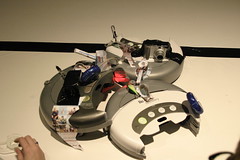
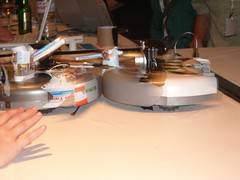
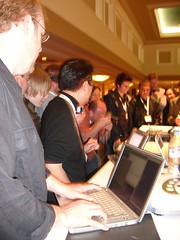
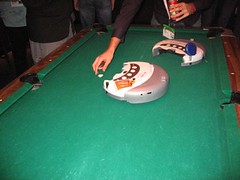
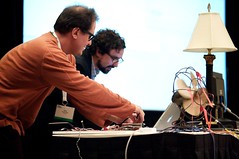
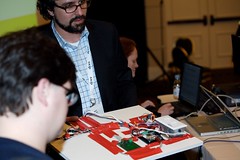




Recent Comments